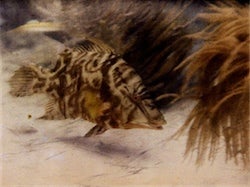The First Color Underwater Photo Was Lit By High Explosives
Underwater lighting wasn't available yet, so these clever photographers relied on high-combustible magnesium powder.


Hogfish
In 1926 Dr. William Longley and National Geographic’s Charles Martin took this photo of a hogfish off the Florida Keys, and ushered in a new generation of underwater photography — this time in color. They needed extremely specialized gear to take the shot, and were faced with a major problem in order to get enough light to properly expose. So, how did they get a burst of light into the ocean? They ended up relying on pounds of magnesium flash powder, floating in a boat on the surface.

While the pair were diving, they left a raft laden with the explosives floating above. When they took the shot, the camera shutter tripped a battery on the raft, igniting the magnesium powder, and illuminating the water down to 15 feet. Hardcore, by the standards of any day.
These images come from a National Geographic timeline of Milestones in Underwater Photography.